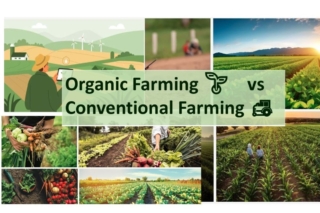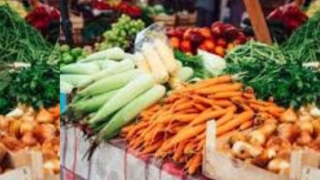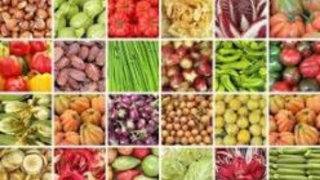Is Organic Farming Really Better? Discover the hidden costs, benefits, and challenges of organic vs. conventional farming. Find out which method offers the best return on investment!”
Introduction
In recent years, the debate between organic farming and conventional farming has gained momentum. With consumers becoming more conscious of their food choices, the demand for organic food has skyrocketed. But is organic farming really better than conventional farming? Which method is more sustainable, profitable, and beneficial for farmers and consumers alike?
In this article, we’ll explore the pros and cons of both organic and conventional farming, analyze market trends, and help you understand which farming method is best suited for modern agriculture.
What is Organic Farming?
Organic farming is a sustainable agricultural practice that avoids synthetic fertilizers, pesticides, genetically modified organisms (GMOs), and artificial additives. Instead, it focuses on natural inputs, crop rotation, composting, and biodiversity to maintain soil health and ecosystem balance.
Key Features of Organic Farming
- No chemical fertilizers or pesticides
- Uses compost, manure, and biological pest control
- Encourages biodiversity and soil health
- No genetically modified organisms (GMOs)
- Follows strict certification standards
Pros of Organic Farming
- Healthier Food: Free from synthetic pesticides and GMOs, making it a healthier choice for consumers.
- Environmentally Friendly: Reduces soil and water contamination, promotes biodiversity, and lowers carbon footprint.
- Better Soil Health: Organic farming practices, such as composting and crop rotation, enhance soil fertility.
- Higher Market Prices: Organic products often fetch 30–50% higher prices than conventional products.
- Sustainable & Resilient: Organic farms are more resistant to climate change and drought conditions.
Cons of Organic Farming
- Lower Yields: Organic farms generally produce 20–30% less yield than conventional farms.
- Higher Costs: Organic farming requires more labor, expensive inputs, and certification fees.
- Pest & Disease Control Challenges: Without synthetic pesticides, organic farmers must rely on alternative methods.
- Shorter Shelf Life: Organic produce often lacks preservatives, leading to faster spoilage.
Who Should Choose Organic Farming?
- Small-scale farmers looking for premium pricing
- Farmers with access to organic certification programs
- Those interested in sustainable and eco-friendly farming
What is Conventional Farming?
Conventional farming, also known as industrial or modern farming, relies on chemical fertilizers, pesticides, and advanced technologies to maximize crop yields. It is widely used across the world to meet global food demands.
Key Features of Conventional Farming
- Uses synthetic fertilizers and pesticides
- Utilizes genetically modified crops (GMOs)
- Focuses on high-yield monoculture farming
- Mechanized and large-scale production
- Heavy irrigation and chemical inputs
Pros of Conventional Farming
- Higher Yields: Conventional farming can produce 2-3 times the yield of organic farming.
- Lower Costs: Mechanization and synthetic inputs reduce labor costs.
- Efficient Land Use: Maximizes productivity per acre, supporting food security.
- Longer shelf life: Processed foods and preservatives increase product longevity.
- Technology-Driven: Utilizes AI, drones, and precision farming for better efficiency.
Cons of Conventional Farming
- Environmental Damage: Pesticides, fertilizers, and monoculture lead to soil degradation and water pollution.
- Health Risks: Chemical residues in food may have potential health risks.
- Loss of biodiversity: Monoculture farming reduces pollinators and beneficial insects.
- Soil Erosion: Excessive chemical use can deplete natural soil fertility.
Who Should Choose Conventional Farming?
- Large-scale farmers looking for high production efficiency
- Those who want fast-growing, high-yield crops
- Farmers in regions with limited access to organic inputs
Market Demand: Organic vs. Conventional Farming
The global organic food market is experiencing exponential growth as more consumers shift toward healthy, eco-friendly diets.https://agroallied.oserichgroup.com/
Market Trends for Organic Farming
- Projected Market Growth: The global organic food market is expected to reach $620 billion by 2030. (Source)
- Consumer Demand: Millennials and Gen Z are driving demand for chemical-free, sustainable food.
- Government Support: Many countries offer subsidies and incentives for organic farming.
Market Trends for Conventional Farming
- Global Food Security: Conventional farming remains essential to feed the world’s growing population.
- Advancements in GMOs: Research in genetically modified crops is improving yields and drought resistance.
- Cost-Effective Solutions: The use of precision agriculture, AI, and automation is making conventional farming more efficient.
Which Farming Method is Better?
Both organic and conventional farming have their advantages and challenges. If you’re looking for higher profits and sustainability, organic farming is a great option. If you prioritize higher yields and efficiency, conventional farming may be more suitable.
Final Comparison Table
| Feature | Organic Farming | Conventional Farming |
| Yield | Lower | Higher |
| Costs | Higher | Lower |
| Health Benefits | High | Moderate |
| Environmental Impact | Low | High |
| Market Demand | Growing | Stable |
| Sustainability | High | Moderate |
Conclusion: The Future of Farming
Both organic and conventional farming play an essential role in modern agriculture. As consumer awareness grows, hybrid farming models that integrate organic practices with modern technology may become the future of food production.
- Want to start your own organic farm? Explore the best organic farming techniques and get certified to maximize your profits!
- Join the conversation! What do you think about organic vs. conventional farming? Share your thoughts in the comments!




